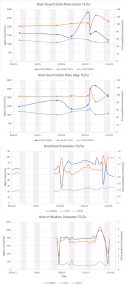Results

Results from ICP-MS analysis are displayed in Figure 1, and raw and processed data are presented in the results link. Trace element ratios in dripwaters collected from BD are between 25 and 80 mmol/mol, 0.9 to 1.45 mmol/mol, and 0.4 to 0.5 mmol/mol for Mg/Ca, Sr/Ca, and Ba/Ca, respectively. All TE/Ca ratios appear to be correlated, except during extreme enrichment events shown as strong peaks, where Sr/Ca and Ba/Ca ratios are oppositely enriched relative to Mg/Ca. HoW samples are much more enriched, with Mg/Ca ratios ranging from 150 to 1000 mmol/mol, Sr/Ca from 2 to 6.5 mmol/mol, and Ba/Ca from 0.5 to 1.2 mmol/mol. All trace element ratios appear to correlate strongly, though the magnitude of enrichment is more consistent in Ba/Ca as compared to Mg/Ca and Sr/Ca ratios.
Scraped calcite ratios are more invariant, with Mg/Ca ratios staying near 1700 mmol/mol, but peak significantly to 2700 mmol/mol during an apparent enrichment event. Similarly, Sr/Ca and Ba/Ca ratios remain around a constant value (110 and 50 mmol/mol, respectively), with excursions up to 130 mmol/mol for Sr/Ca and 65 mmol/mol for Ba. There do not appear to be significant differences in the ranges and intensity of TE/Ca ratios in the sample location on each plate, but there does seem to be a difference in timing of the early 2018 enrichment event.
Total cost: 70 samples x $17/sample = $1190